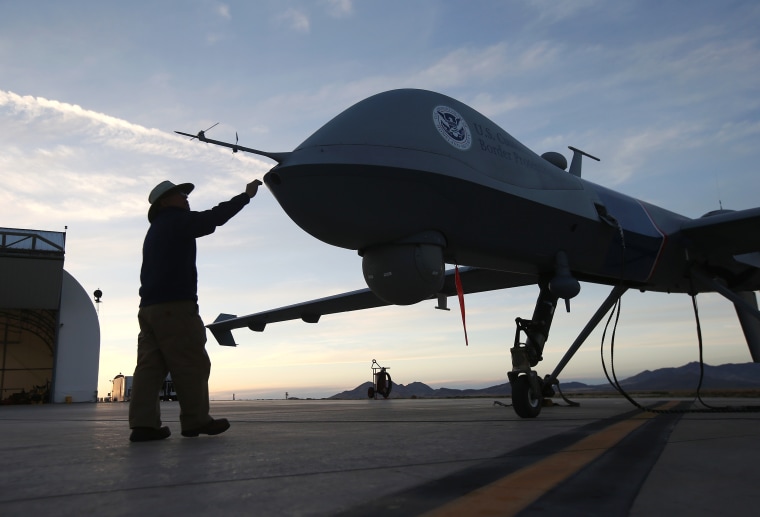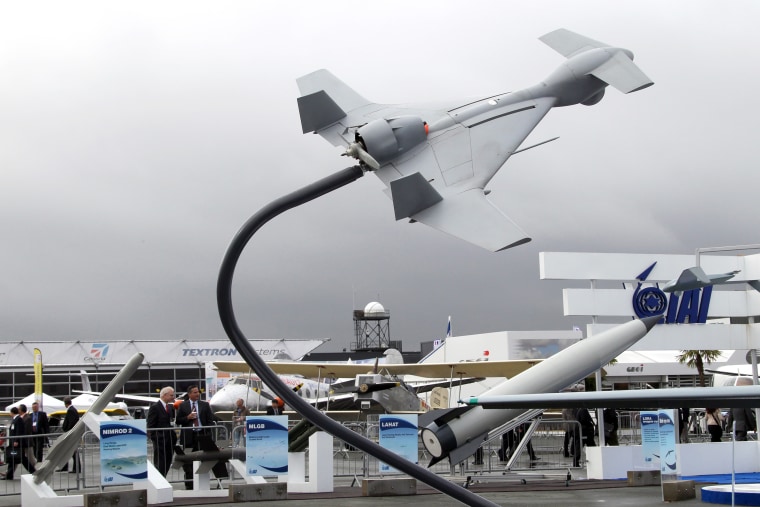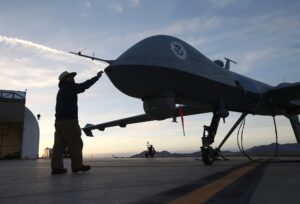
Maintenance personnel check a Predator drone operated by the U.S. Office of Air and Marine Operations in 2013.John Moore / Getty Images file
Armenia and Azerbaijan have been in a state of conflict for several decades over the disputed Nagorno-Karabakh region, but a deluge of grisly video released by the combatants in recent days shows that it’s now being fought in a newer high-tech — and highly lethal — fashion.
The situation can only be worsened by the Trump administration’s push to deregulate armed drone sales in a bid to allow American manufacturers to compete in the export market.
One particularly startling video seems to show Armenian soldiers desperately firing into the sky as an ominous buzzing sound increases in pitch like a German World War II dive bomber. Seconds later, a drone plunges into the roof of a bus, its 50-pound warhead consuming the vehicle in a ball of fire.
It’s just an example of how armed drones, or Unmanned Combat Air Vehicles — UCAVs — in military speak, are upping the casualties in long-simmering regional conflicts that until now have been low-level — limited in large part by smaller countries’ inability to make precision strikes on forces at and beyond the front line.
When modern drone strikes made their confirmed debut with the Predator just a few weeks after the terrorist attacks of Sept. 11, 2001, they were wielded by powerful countries like the United States against insurgents and terrorists, such as the Taliban and Al Qaeda.
But that’s changing as drone technology proliferates among smaller countries in conflict hot spots from Libya to the Caucasus Mountains. Unfortunately, as fighting in Nagorno-Karabakh suggests, using drones to make it easier to wage air wars is likely to lead to more such wars.
That this didn’t happen sooner may be in part because the U.S. tightly restricted the export of its expensive Predator and Reaper UCAVs to close allies. But China, Israel and Turkey developed their own UCAVs, which they have widely exported (and, in the latter two cases, used extensively).
Just in 2020 alone, drones from these countries were used in three wars pitting state actors against each other, often with decisive impact.

The United Arab Emirates deployed Chinese-built Wing Loong drones last year to support the Libyan National Army faction inside Libya, where they gained infamy for deadly strikes using laser-guided Blue Arrow missiles. When Turkey intervened in behalf of the opposing side, it deployed a fleet of domestically built Bayraktar TB2 drones, which eventually overwhelmed and destroyed most of the Libyan National Army’s Russian-built air defense systems, forcing the army to end its siege of Tripoli and withdraw from a key air base this May.
Turkish drones also swooped down this year on Bashar al-Assad’s forces in Syria’s Idlib province, destroying over 100 armored vehicles — bringing Assad’s initially successful assault on the rebel stronghold reeling to a halt.
And at some point Turkey transferred Bayraktar drones to Azerbaijan, which has been locked for over three decades in a conflict with Armenia over the Nagorno-Karabakh region. Late last month, Azerbaijan launched a broad ground and air offensive, using the drones to destroy at least a dozen Armenian air defense systems in the early hours of the conflict. Azerbaijan has since released videos of the drones destroying dozens of Armenian tanks and artillery systems, as well as resupply and reinforcement convoys.
But that’s not the only armed drone at Azerbaijan’s disposal. The Bayraktar supplements the Israeli-built Harop (Harpy) drone responsible for the bus attack, a “loitering munition” that combines the remote control and long endurance attributes of a drone with the deadly strike capabilities of a guided missile.

These advanced capabilities are highly lethal, but they come at a relatively low cost for the governments involved.
A jet fighter costs tens of millions of dollars to procure and tens of thousands of dollars per flight hour to operate and maintain — and, most importantly, it has a highly trained, nonexpendable pilot on board. Risking the loss of a manned jet and its pilot is often seen as unacceptable materially and politically in anything short of an all-out high-intensity conflict. New combat drones from China and Turkey, by contrast, cost in the low millions of dollars, are significantly cheaper to fly per hour and — without pilots on board — are much more expendable.
To be sure, such drones are far from indestructible. In each of the war zones mentioned, significant numbers have been shot down by short-range air defenses. But that just highlights how drones can be used more aggressively, since a lost drone doesn’t put the operator’s life at risk.
And because UCAVs have less carrying capacity than manned jets, they use small but precise missiles, rather than crude, unguided bombs and rockets. That teaches new adopters of armed drones, like Azerbaijan, precision strike warfare methods formerly exclusive to wealthier militaries.
Furthermore, drones can prove deadly simply by acting as spotters to identify targets to strike with artillery fire. And even wealthy countries, let alone states like Armenia, are struggling to field effective defenses against swarms of small, expendable drones, giving attackers an advantage for the time being.
In short, drones are giving smaller countries affordable ways to project force with greater lethality at lower risk. And that is likely to tempt many countries to resort to force more often if the United States’ rampant use of drones to assassinate “high-value targets” is anything to go by.
And there are other places beyond Nagorno-Karabakh where long-standing “frozen” conflicts might be reawakened if one side obtains what it perceives as game-changing drone capabilities. Countries with outstanding border conflicts like India, Pakistan, Serbia and Ukraine are all purchasing attack drones.
The situation can only be worsened by the Trump administration’s push to deregulate armed drone sales in a bid to allow U.S. manufacturers to compete in an export market dominated by China, Israel and Turkey. Instead, Washington should sell potentially destabilizing offensive weapons only to trustworthy allies, such as Japan and Germany, that can be counted upon to use them in ways that advance U.S. interests and that are in keeping with American values.
Yes, that means that many clients will continue to buy armed drones from other countries and that drone proliferation will likely continue to increase the risks of military aggression between less wealthy countries. But we don’t need to worsen the problem by making America’s more capable unmanned killing machines more widely available, allowing pursuit of arms sales to contradict our broader national interest of a more stable and peaceful world.





